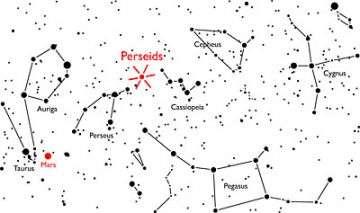Natural fireworks, courtesy of the Perseid meteor shower

As the Perseid meteor shower becomes visible in all its glory on 13 August, natural fireworks will fill the sky. Showers of meteors, or ‘shooting stars’, appear as bright streaks of light in the sky. The display runs through the night.
Dust trails are left behind by every comet as it nears the Sun. As Earth’s orbit crosses the dust ejected by the comet Swift-Tuttle, a regular occurrence every August, it provides a fabulous spectacle for viewers on Earth. As the particles enter the atmosphere, they burn up, producing the fireworks. This phenomenon, called the ‘Perseid’ meteor shower, gets its name from the constellation Perseus, from where the shooting stars seem to come.
This year the Perseids are visible from 17 July to 24 August. One or two per hour can be seen at the start, increasing to about five to ten per hour in early August. The display will be at its maximum before sunrise on 13 August, when 80 to 100 meteors should be visible every hour, weather permitting.
The best time to go observing is during the pre-dawn hours of 13 August. The occurrence of a new Moon on 12 August will make for perfect observing conditions.
Even if the sky may not be totally clear, you can expect to see tens of meteors in the sky from all over Europe. The display will be on all night, starting from about 23:00 CEST on 12 August, peaking before sunrise on the 13th. This year, as a bonus, Mars is visible as a bright red dot in the East, after midnight.
Telescopes or binoculars will not be necessary as the shower is visible with the naked eye. It is important to be in a dark area, without much smog, pollution or illumination. Do make yourself comfortable – use a reclining chair or spread a blanket on the ground. The shooting stars will appear all over the sky, you need not look in a particular direction. Just make sure your eyes can adapt to dark.
The Meteor Research Group at ESA is performing coordinated observations at several locations in Austria and Germany in collaboration with the German Aerospace Center (DLR) and three more participating institutes: The ‘Institut für Weltraumforschung’, Austria, Technische Universität Berlin, Germany and the Max Planck Institute for Solar System Research, Germany.
A detailed list of all observation posts can be found on the map. After the observations are conducted, we will publish pictures provided by ESA’s observation teams. Stay tuned!
Source: ESA





















